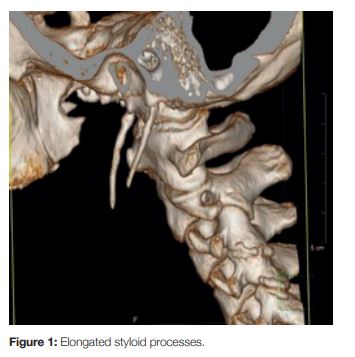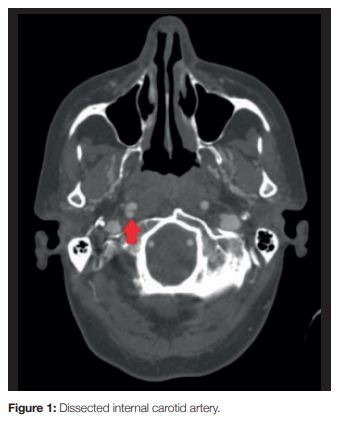Serviços Personalizados
Journal
Artigo
Indicadores
-
 Citado por SciELO
Citado por SciELO -
 Acessos
Acessos
Links relacionados
-
 Similares em
SciELO
Similares em
SciELO
Compartilhar
Medicina Interna
versão impressa ISSN 0872-671X
Medicina Interna vol.26 no.1 Lisboa mar. 2019
https://doi.org/10.24950/rspmi/imagem/226/1/2019
IMAGENS EM MEDICINA / IMAGES IN MEDICINE
Vascular Eagle Syndrome
Síndrome de Eagle Vascular
Erico Costa1
 https://orcid.org/0000-0003-0600-4427
https://orcid.org/0000-0003-0600-4427
Lúcia Guedes1
 https://orcid.org/0000-0001-6626-0380
https://orcid.org/0000-0001-6626-0380
Luís Fontão2
 https://orcid.org/0000-0002-8036-786X
https://orcid.org/0000-0002-8036-786X
1Serviço Medicina Interna, Centro Hospitalar Entre Douro e Vouga, Santa Maria da Feira, Portugal
2Serviço de Neurologia, Centro Hospitalar Entre Douro e Vouga, Santa Maria da Feira, Portugal
Keywords: Carotid Artery, Internal, Dissection; Ossification, Heterotopic
Palavras-chave:Dissecação da Artéria Carótida Interna; Ossificação Heterotópica
Eagle syndrome is a rare condition characterized by elongated styloid process or calcification of the stylohyoid ligament causing pain by nervous irritation triggered by swallowing, mandibular movements or similar.1 In the vascular form, the styloid process contacts with the internal carotid artery compressing it or causing dissection and neurological complications.2
A 51-year-old female with no priors sought medical attention for cervicalgia, facial and upper limb paresthesia which evolved to paresis after abrupt cervical movement. A computed tomography angiography showed elongated styloid processes (Fig 1 ), a dissected internal carotid artery (Fig 2 ) and two cerebral infarcts.
Elongated styloid processes imply a four-time greater risk of carotid dissection.3 Stylocarotid syndrome is a rare vascular variant of Eagle syndrome4 and carotid dissection is its rarest complication. In the present case no previous symptoms were documented, thus being cerebral embolization the first manifestation.


References
1. Eagle WW. Elongated styloid processes: Report of two cases. Arch Otolaryngol. 1937; 47: 584–7.
2. Kamal A, Nazir R, Usman M, Salam BU, Sana F. Eagle syndrome; radiological evaluation and management´. J Pak Med Assoc. 2014;64:1315-7. [ Links ]
3. Raser JM, Mullen MT, Kasner SE, Cucchiara BL, Messé SR. Cervical carotid artery dissection is associated with styloid process length. Neurology. 2011;77:2061-6. http://dx.doi.org/10.1212/WNL.0b013e31823b4729. [ Links ]
4. Smoot TW, Taha A, Tarlov N, Riebe B. Eagle syndrome: A case report of stylocarotid syndrome with internal carotid artery dissection. Interv Neuroradiol. 2017;23:433-6. http://dx.doi.org/10.1177/1591019917706050. [ Links ]
Correspondência:Érico Costa ericorudi@gmail.com
Serviço Medicina Interna, Centro Hospitalar Entre Douro e Vouga, Santa Maria da Feira, Portugal
R. Dr. Cândido Pinho 5, 4520-211 Santa Maria da Feira
Conflitos de Interesse: Os autores declaram a inexistência de conflitos de interesse na realização do presente trabalho.
Fontes de Financiamento: Não existiram fontes externas de financiamento para a realização deste artigo.
Direito à Privacidade e Consentimento Informado: Os autores declaram que nenhum dado que permita a identificação do doente aparece neste artigo.
Proteção de Seres Humanos e Animais: Os autores declaram que não foram realizadas experiências em seres humanos ou animais.
Proveniência e revisão por pares: Não comissionado; revisão externa por pares.
Conflicts of interest: The authors have no conflicts of interest to declare.
Financing Support: This work has not received any contribution, grant or scholarship.
Confidentiality of data: The authors declare that they have followed the protocols of their work center on the publication of data from patients.
Protection of human and animal subjects: The authors declare that the procedures followed were in accordance with the regulations of the relevant clinical research ethics committee and with those of the Code of Ethics of the World Medical Association (Declaration of Helsinki).
Provenance and peer review. Not commissioned; externally peer reviewed
Recebido: 26/09/2018
Aceite: 14/10/2018














